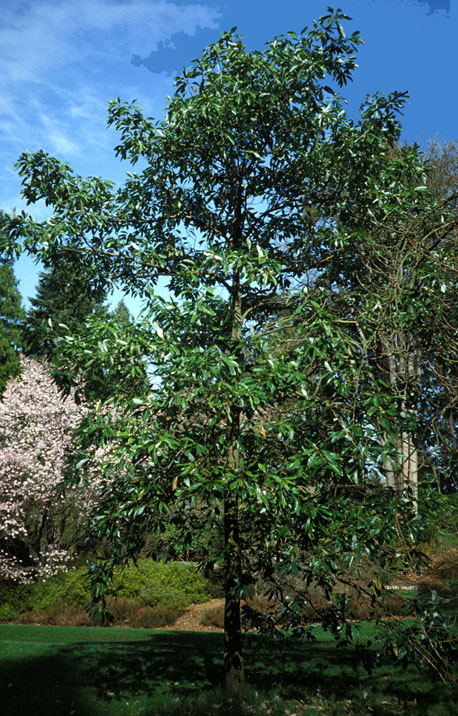Plant of the Month: February 2003
|
| Sweetbay |
| Magnolia virginiana L. |
MAGNOLIACEÆ; Magnolia Family
|
| The Sweet Bay was among the first species to be named in the genus Magnolia, when in 1753 the great botanist Linnaeus commemorated Pierre Magnol (1638 - 1715), French professor of botany at Montpelier. Magnolias are planted primarily because of their glorious flowers; a few species are valued quite as much for their foliage; one (M. acuminata) serves as a large shade tree. They are woodland trees for the most part, and hate dry or sterile soil. Dull fall color is a drawback of most. The Sweetbay itself can be evergreen, semi-evergreen or deciduous; its evergreen specimens are by far superior ornamentals and it is to champion them that I write this article. Evergreen sweetbays are undeservedly rare; the deciduous ones are scarcely worth growing in contrast. |
| The species is native essentially to the U.S. Coastal Plain from Massachusetts south to Florida and west to southeastern Texas. I guess it is called the sweet bay because it smells sweet and has slender aromatic leaves that maybe recalled those of the original bay tree. Other names include: silver bay, white laurel, beaver tree, swamp laurel, swamp sassafras, white bay, and swamp bay. According to John Loudon (1838), it was called beaverwood "because the root is eaten as a great dainty by the beavers, and these animals are caught by means of it." and François André Michaux (1770 - 1855), a keen, widely traveled naturalist, said that beavers prefer it to any other wood for constructing their dams on account of the softness of the wood. |
| As for its appearance, it varies from a suckering shrub to a tree with a strong tendency to fork. Overall it is more slender and less stout than most magnolias. The foliage is of an elegant or graceful texture, and the leaves are sparkling dark green above, ghostly pale beneath, affording a pleasing contrast; the largest leaves measure up to 8 inches long and 3 inches wide. It is the cheerful winter greenery that makes the evergreen sweetbays so superior to the deciduous ones, as the latter lack remarkably attractive fall color. |
| Sweetbay flowers are, for a magnolia, small (2 to 4 inches wide), creamy-white, lemony or rose-scented, and appear from May into July or even September. This long flowering period is an asset. The flowers give rise to knobby red seed-cones that contain plump orange seeds. |
| The sweetbay is valuable as an ornamental because it can grow in very wet soils, yet also tolerates drier sites. It may, unlike most magnolias in cultivation, resist verticillium wilt fungal disease. It does not grow too large for the average residential garden, and with pruning is easily kept in line. Since it tends to sucker from the base, pruning away suckers is apt to be an annual task. |
| The largest sweetbays ever recorded have surpassed 90 feet in height. These are many decades old, in Florida. For all practical purposes sweetbay is a small tree, even a large shrub. The largest known in Seattle was a multiple-trunked specimen 60 feet tall in 1988, but it was cut down some years thereafter. |
| In 1930 - 1931 the sweetbay was intentionally hybridized with Magnolia grandiflora and clones distributed of this parentage include 'Freeman' and 'Maryland'; they less resemble sweetbay than they do their other parent. Sweetbay crossed with Magnolia tripetala is called Magnolia x Thompsoniana --the first magnolia hybrid known, at least in the Western world. It was named after Archibald Thompson, (1753 - 1832), the London nurseryman who raised it in 1808. Still other sweetbay hybrids exist, but I prefer to focus here on its purebred, evergreen, versions. |
| Sometimes the name Magnolia virginiana var. australis has been used to designate evergreen sweetbays. Named in 1919, australis, in Latin, means of or from the south. Overall this version is more abundant in the wild. Its flowers self-incompatible. Its fragrance is stronger, and more lemon-like. Its leaves are often evergreen. It is often a large tree. In contrast the ordinary sweetbay is relatively self-fertile, weaker-scented, always deciduous, more cold-hardy, and usually shrubby. |
If you visit a nursery and ask for an evergreen magnolia, likely a salesperson will assume you desire Magnolia grandiflora; the salesperson may not even know that evergreen sweetbay seedlings or clones exist. Several evergreen clones have been named. The only one that I have seen for sale in Seattle-area nurseries is called 'Henry Hicks' --that originated as a tree given by Long Island nurseryman Henry Hicks (1870 - 1954) to Swarthmore College, Pennsylvania. The tree was named in or before 1967, because it holds its leaves all year, even in the north. In the summer of 2002 I saw 5-gallon sizes of 'Henry Hicks' for sale at about $40 each.
Back
|

Evergreen Sweetbay tree photo by ALJ
|

Evergreen Sweetbay foliage scan by ALJ
|
|
|

